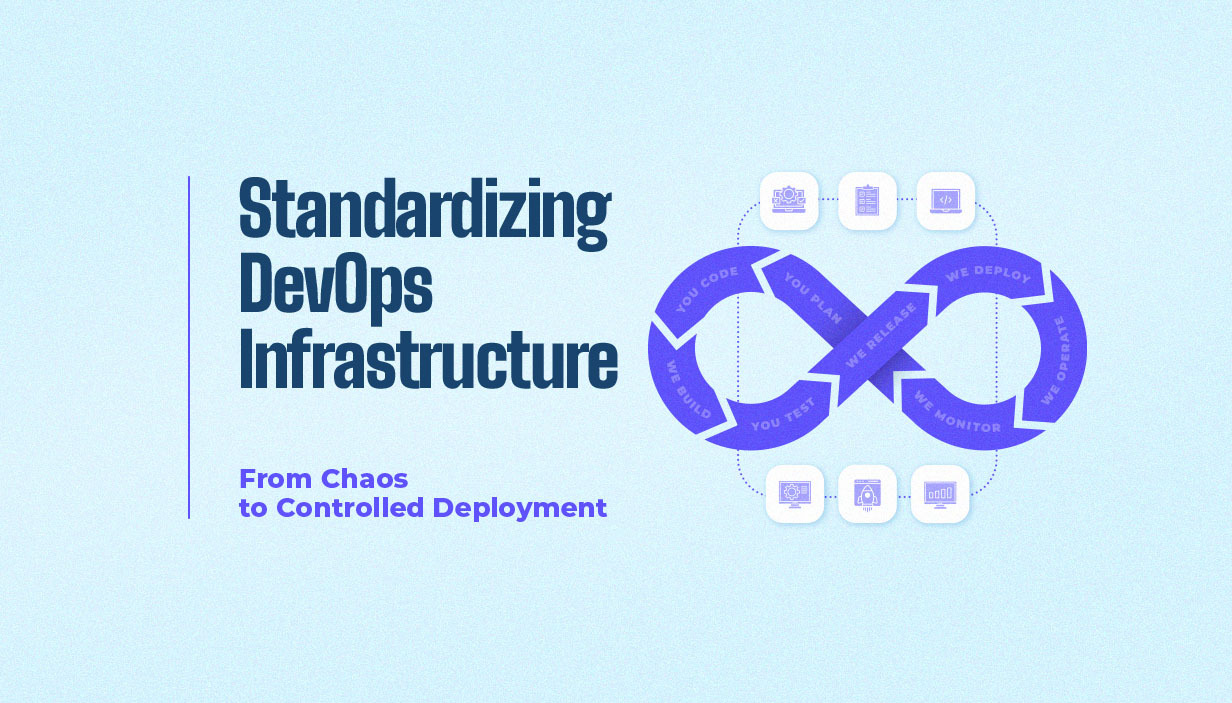Organizations in the software industry increasingly recognize that standardizing DevOps infrastructure is the difference between chaotic development processes and controlled, reliable deployments. In a competitive software development market, DevOps practices such as continuous integration (CI), continuous delivery (CD), and infrastructure as code (IaC) have transformed the way development teams and operations teams build, refine, and release high-quality software. Yet, without standardized infrastructure configurations, repeatable processes, and established best practices, many organizations fail to realize DevOps excellence.
By introducing a resilient, standardized DevOps pipeline, organizations streamline the software development lifecycle through automated workflows, integration testing, and consistent deployment processes. This allows development teams to deliver at a faster pace, reduce human error, and scale their cloud infrastructure effectively. More companies now create centralized competence teams to manage current infrastructure and ensure all projects follow common templates and governance.
This article explores how to transform chaotic DevOps setups into controlled deployment environments, covering core components, automation strategies, common challenges, and best practices to achieve operational excellence.
Key Takeaways
- Standardizing DevOps infrastructure eliminates error-prone manual processes and transforms chaos into predictable, repeatable deployment processes.
- Automation through IaC tools, CI/CD pipelines, and orchestration tools reduces human error by up to 45%, ensuring consistent infrastructure changes across various environments.
- Elite DevOps teams deploy 208x more frequently, with a 7x lower change failure rate, thanks to standardized environments and continuous improvement practices.
- Central governance prevents tool sprawl and enforces best practices across two teams (development and operations) reducing security risks and integration issues.
- Security and compliance must be embedded into processes using automation and role-based access control (RBAC), not bolted on at the end.
Understanding DevOps Infrastructure in Modern Teams
Strong DevOps infrastructure is the backbone of any successful software development strategy. It connects different stages of the DevOps process, from writing application code to releasing into production environments.
Definition and Scope of DevOps Infrastructure
DevOps infrastructure encompasses the systems, resources, tools, and processes that connect development teams and operations teams. It enables continuous feedback, reduces manual intervention, and ensures consistency in infrastructure configurations. Key elements include version control systems, orchestration tools like Kubernetes, cloud platforms for scalability, and infrastructure as code (IaC) for predictable deployments.
The purpose is clear: to create a collaborative, automated development environment that accelerates delivery, improves quality, and ensures stability in production systems.
Why Infrastructure DevOps Matters in 2024
In 2024, the DevOps landscape is defined by speed, quality, and scalability. The latest State of DevOps reports highlight that organizations with mature DevOps practices see higher productivity, reduced developer burnout, and improved software quality.
Standardizing infrastructure:
- Enables continuous integration and continuous deployment pipelines.
- Provides repeatable environments through infrastructure as code IaC.
- Automates unit testing, continuous testing, and automated testing.
- Scales cloud infrastructure in response to demand without compromising security.
Elite DevOps teams using standardized infrastructure achieve operational excellence, deploying more often, faster, and with fewer failures than low performers.
Key Differences from Traditional IT Infrastructure
Unlike traditional IT, which separates development and operations, DevOps infrastructure fosters collaboration and shared responsibility.
Traditional IT relies heavily on manual infrastructure changes and lengthy approval cycles, which slow down the entire development process. Work typically moves through sequential departmental handoffs, creating delays and communication gaps. The overall focus remains on stability rather than agility, often at the expense of innovation and rapid delivery.
In contrast, DevOps infrastructure embraces automated workflows powered by CI/CD pipelines, enabling faster and more reliable deployments. Real-time integration testing ensures that issues are caught early, while rapid deployment processes keep delivery timelines short. Failures are seen as inevitable learning opportunities, with systems designed to work proactively and recover quickly.
Core Components of a Standardized DevOps Infrastructure
A high-functioning DevOps infrastructure requires integrated tools and processes:
- Version Control Systems (Git, GitHub, GitLab) – Central to tracking software code and enabling continuous improvement.
- CI/CD Pipelines (Jenkins, GitHub Actions, CircleCI) – Automating development, integration testing, and deployment processes.
- Infrastructure as Code (Terraform, AWS CloudFormation, Ansible) – Eliminating error-prone manual processes in infrastructure configurations.
- Monitoring and Logging (Prometheus, ELK Stack) – Detecting issues before they impact production environments.
- Collaboration Tools (Slack, Jira, Confluence) – Enhancing coordination between two teams through a user-friendly interface.
Automation and Orchestration for Controlled Deployment
Automation is the engine of DevOps excellence. By leveraging automation, organizations can ensure consistent and efficient operations across the entire software development lifecycle. Automated provisioning with Infrastructure as Code (IaC) tools guarantees consistent setups across various environments. Container orchestration with Kubernetes maintains the desired state of applications and scales them dynamically to meet demand. Automated testing, integrated directly into CI/CD pipelines, helps ensure that only high-quality software reaches production. Workflow automation platforms further reduce repetitive tasks and minimize manual intervention in deployment processes, improving speed and reliability.
Challenges in DevOps Infrastructure Standardization
While standardizing DevOps infrastructure offers several benefits, it comes with common challenges:
- Tool fragmentation – choosing the wrong tools for current infrastructure leads to inefficiency.
- Lack of central governance – no single authority to enforce practices and KPIs.
- Cultural resistance – staff reluctant to change manual processes.
- Security risks – automation without compliance controls introduces vulnerabilities.
Best Practices for Achieving Infrastructure Standardization
- Establish a Central DevOps Team – Aligns two teams with governance and processes.
- Template-Based Provisioning – Standard IaC templates for cloud platforms like AWS, Azure, and GCP.
- Define and Track KPIs – Measure deployment process efficiency, change failure rate, and recovery time.
- Role-Based Access Control (RBAC) – Protects production systems and meets compliance requirements.
- Adoption Frameworks – Guide organizations through different stages of DevOps maturity.
How CTO2B Powers Infrastructure Standardization
At CTO2B, we specialize in helping organizations move from chaotic DevOps setups to controlled deployment processes even in environments affected by tech talent shortages.
Our automation platform allows development teams and operations teams to:
- Provision cloud infrastructure using secure, pre-approved IaC templates.
- Standardize infrastructure configurations across various environments without deep cloud expertise.
- Automate compliance checks and reduce human error in deployment processes.
- Enable self-service environments that cut provisioning times from days to hours.
By leveraging automation and right tools, CTO2B reduces dependency on scarce DevOps teams and empowers skilled developers to focus on building innovative solutions instead of managing infrastructure.
Conclusion
Moving from chaos to controlled deployment requires standardizing DevOps infrastructure with the right tools, automation strategies, and governance. When development teams and operations teams collaborate through standardized DevOps practices, organizations achieve operational excellence, reduce security risks, and deliver high-quality software faster.
Whether your challenge is tool fragmentation, manual processes, or lack of governance, adopting infrastructure as code IaC, automation, and standardized workflows will set the foundation for sustainable success.
FAQs
What are the key components of a standardized DevOps infrastructure?
The key components include version control systems (like Git), CI/CD pipelines (such as Jenkins or GitHub Actions), Infrastructure as Code tools (like Terraform), monitoring solutions (like Prometheus), and collaboration platforms (such as Slack or Jira).
How does automation contribute to controlled deployment in DevOps?
Automation reduces human error, increases deployment speed, and improves reliability. It enables consistent environment setups, automates testing and deployment processes, and allows for rapid response to changes and issues.
What are some common challenges in standardizing DevOps infrastructure?
Common challenges include tool fragmentation and integration issues, lack of central governance, cultural resistance to change, and security and compliance gaps in automated processes.
What are some best practices for achieving DevOps infrastructure standardization?
Best practices include establishing a central DevOps team, using template-based infrastructure provisioning, defining and tracking DevOps KPIs, implementing role-based access control, and utilizing DevOps adoption frameworks.
How does standardizing DevOps infrastructure benefit an organization?
Standardization leads to faster software delivery, higher quality outputs, improved scalability, and better adaptability to market changes. It also enhances collaboration between teams, reduces errors, and provides a foundation for both innovation and operational stability.


